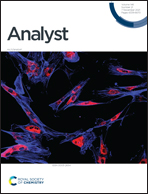Room-temperature growth of covalent organic frameworks as the stationary phase for open-tubular capillary electrochromatography†
Abstract
Covalent organic frameworks (COFs) are a class of porous materials with high surface area, high porosity, good stability and tunable structure that have been widely used in the separation area. In this work, we have proposed the in situ synthesis of a novel COF composed of 4,4′,4′′-(1,3,5-triazine-2,4,6-triyl)trianiline (Tz) and 1,4-dihydroxyterephthalaldehyde (Da) onto the capillary inner surface for electrochromatographic separation. Fourier transform infrared (FT-IR) spectroscopy, elemental analysis (EA) and scanning electron microscopy (SEM) have facilitated the characterization of the prepared capillary columns. The COF (TzDa) modified OT-CEC column exhibited satisfactory separation selectivity towards neutral compounds (such as chlorobenzenes and alkylbenzenes), acidic and basic compounds (such as phenols and anilines), food additives (vanillin and its analogues) and small biomolecules (such as amino acids and polypeptides). Furthermore, the TzDa modified capillary was quite stable and reproducible. The relative standard deviations for retention times of the test analytes (alkylbenzenes) were as follows: for intra-day (n = 3) runs (≤1.74%), inter-day (n = 3) runs (≤2.25%) and between columns (n = 3) (≤4.83%). This new type of COF-based stationary phase has tremendous potential in separation science.



 Please wait while we load your content...
Please wait while we load your content...